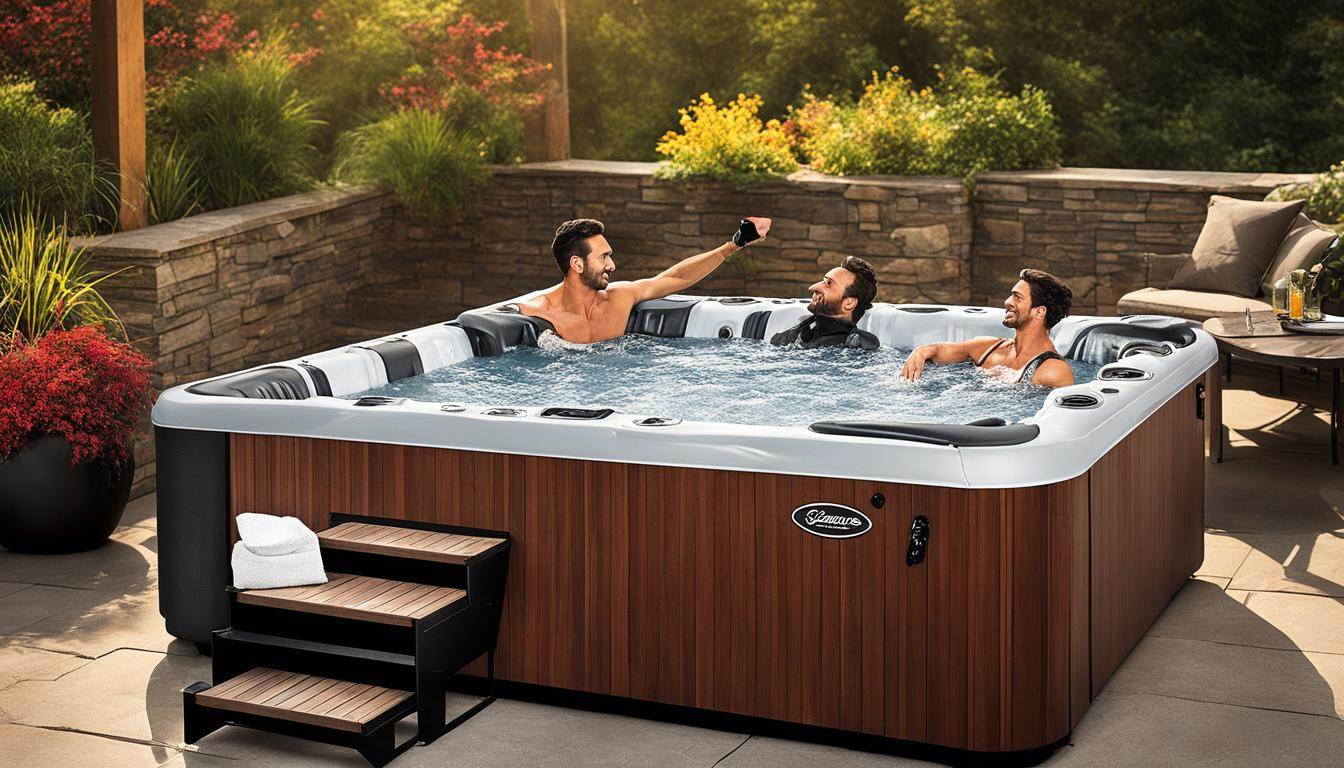Overview of Types of Hot Tubs
When it comes to creating a spa-like experience at home, hot tubs are an excellent option. With a variety of types available, there is something to suit everyone’s preferences and budget. Understanding the different types of hot tubs can help you make an informed decision about which features, size, and functions are best for you.
Portable Hot Tubs
Portable hot tubs are a popular choice for many homeowners due to their convenience and affordability. These tubs are easy to install and can be moved around as needed. They typically come in smaller sizes, making them ideal for those with limited outdoor space.
Key Features:
- Lightweight and easy to transport
- Plug-and-play models: simply plug into a standard electrical outlet
- Inflatable options available
- Affordable price range
Above-Ground Hot Tubs
Above-ground hot tubs are another option to consider. These tubs are typically made from acrylic or fiberglass and offer a more permanent installation. They are available in various sizes and can accommodate a larger number of people.
Key Features:
- Sturdy construction
- Built-in seating and jets
- Options for heating and filtration systems
- More customizable than portable hot tubs
- Higher price range compared to portable tubs
In-Ground Hot Tubs
For those looking for a more luxurious option, in-ground hot tubs are worth considering. These tubs are built into the ground and offer a sleek and integrated look. In-ground hot tubs often require professional installation and can be more expensive than portable or above-ground options.
Key Features:
- Customizable designs and shapes
- Built-in benches and steps
- Options for decking and landscaping integration
- Permanent and durable installation
- Higher price range compared to other types
Swim Spas
Swim spas are a combination of a hot tub and a swimming pool, offering the benefits of both. These larger units are designed for swimming, exercise, and relaxation. They are suitable for those with more space and a higher budget.
Key Features:
- Adjustable current for swimming against
- Built-in seating and hydrotherapy jets
- Great for exercise and relaxation
- Can be used year-round
- Higher price range compared to other types
1. Benefits of a Wooden Hot Tub
One of the main benefits of a wooden hot tub is its traditional and rustic appeal. Many people are drawn to the warm and natural look that wooden hot tubs provide.
Wooden hot tubs also tend to have a deeper seating compared to other types of hot tubs. This allows for a more immersive and comfortable experience when soaking in the tub.
Furthermore, wooden hot tubs are often customizable and can be built to fit specific sizes and shapes. This makes it possible to create a hot tub that perfectly fits your space and meets your needs.
Another advantage of wooden hot tubs is their ability to blend seamlessly with outdoor surroundings. With their organic and earthy appearance, they can enhance the overall aesthetic of your outdoor space.
2. Maintenance and Care Tips for Wooden Hot Tubs
To ensure the longevity and optimal performance of a wooden hot tub, regular maintenance is necessary. Here are some maintenance and care tips to keep in mind:
– Regularly check the water chemistry and maintain proper sanitization levels to prevent the growth of bacteria and algae.
- Keep the water balanced by regularly testing and adjusting the pH, alkalinity, and sanitizer levels.
- Clean the wood surfaces periodically to remove dirt, debris, and any buildup. Avoid using harsh chemicals or abrasive cleaners that can damage the wood.
- Depending on the type of wood used, it may be necessary to apply a protective stain or sealant to prevent water damage and extend the lifespan of the tub.
- Monitor the water temperature and use a cover to minimize heat loss and conserve energy.
- In regions with freezing temperatures, make sure to winterize the wooden hot tub to prevent damage from ice expansion. This may involve draining the tub and protecting it with a cover or insulating material.
- Regularly inspect the wooden components, such as the staves and bands, for any signs of wear or damage. Address any repairs promptly to prevent further damage.
- Consider investing in a quality hot tub cover to protect the tub from the elements when not in use.
- Follow the manufacturer’s instructions and guidelines for maintenance specific to your wooden hot tub model.
By following these maintenance tips, you can ensure the longevity and enjoyment of your wooden hot tub.
In-Ground Hot Tub
1. Advantages of an In-Ground Hot Tub
An in-ground hot tub offers several advantages that make it a popular choice for many homeowners. Here are some of the key benefits:
- Seamless Integration: In-ground hot tubs can be built next to or as part of an existing outdoor swimming pool. This allows for a seamless integration of the hot tub into the overall pool area, creating a cohesive and visually appealing space.
- Enhanced Aesthetic: By being built into the ground, in-ground hot tubs offer a more polished and sophisticated look compared to above-ground tubs. The sleek and streamlined design can elevate the aesthetic of the entire outdoor area.
- Increased Privacy: In-ground hot tubs are often surrounded by landscaping or fencing, providing a greater sense of privacy while enjoying a soothing soak. This can enhance the relaxation and tranquility of the experience.
- Accessibility: In-ground hot tubs can be customized to be easily accessible for individuals with mobility issues. For example, they can be equipped with step-in or lift systems to ensure everyone can enjoy the therapeutic benefits of hydrotherapy.
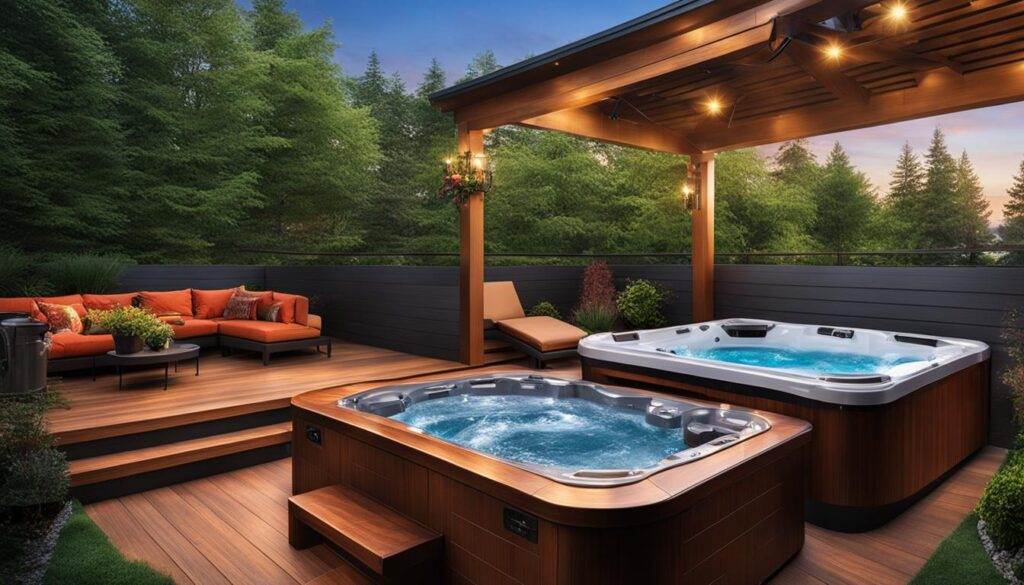
2. Installation Considerations for In-Ground Hot Tubs
Installing an in-ground hot tub requires careful planning and consideration. Here are some key installation considerations:
- Professional Assistance: It is highly recommended to seek professional help for the installation of an in-ground hot tub. Excavation and construction work may be required, and experts can ensure proper installation and adherence to building codes.
- Location: Choose a suitable location for the hot tub, considering factors such as proximity to the house, sunlight exposure, and views. Assess the accessibility of utility connections, such as water and electricity, to ensure proper installation.
- Design and Materials: Select the design and materials that complement your outdoor space and personal preferences. Consider factors such as durability, maintenance requirements, and compatibility with the overall landscape design.
- Electrical Connections: Ensure that the electrical requirements for the hot tub are met. This may involve hiring a licensed electrician to handle the wiring and ensure compliance with safety regulations.
- Plumbing and Draining: Proper plumbing and drainage systems should be installed to ensure efficient operation and to prevent water damage. Work with professionals to ensure proper connections and prevent any potential issues.
- Safety Considerations: Install safety measures, such as fencing, covers, or locks, to prevent unauthorized access to the hot tub. Follow local regulations and guidelines for safety requirements specific to your area.
Portable Hot Tub
1. Features and Benefits of a Portable Hot Tub
A portable hot tub offers several advantages that make it a popular choice among homeowners. Here are some key features and benefits:
- Easy to move: As the name suggests, portable hot tubs are designed to be easily transported. They are often lightweight and come with built-in handles or wheels, allowing you to move them around your property as needed.
- Affordable: Portable hot tubs are generally more budget-friendly compared to other types of hot tubs. They offer a cost-effective option for those who want to enjoy the benefits of a hot tub without breaking the bank.
- Various features: Despite their portable nature, these hot tubs still come with a range of features and amenities. These may include air jets, contoured seating, adjustable water jets, LED lighting, and even built-in sound systems. These features enhance the overall relaxation experience.
- Flexible installation: Portable hot tubs offer flexible installation options. They can be placed on a deck, patio, or directly on the ground. Some models can also be installed indoors, making them suitable for year-round use.
- Efficient drainage and filtration systems: Portable hot tubs are equipped with efficient drainage and filtration systems. These systems help to keep the water clean and ensure optimal performance.
- Durable: Despite being lightweight, portable hot tubs are built to withstand various weather conditions. They are typically made from durable materials that can withstand the elements, ensuring long-lasting use.
2. Factors to Consider When Choosing a Portable Hot Tub
When selecting a portable hot tub, there are several factors to consider to ensure you make the right choice. Here are some important considerations:
- Size and capacity: Determine the size and capacity that will comfortably accommodate your needs. Consider the number of people who will be using the hot tub at a time and the available space for installation.
- Features: Assess the features and amenities offered by different portable hot tub models. Consider your preferences and priorities, such as the number and type of jets, seating arrangement, control options, and additional features like LED lighting or Bluetooth connectivity.
- Energy efficiency: Look for a portable hot tub with energy-efficient features. Insulated covers, efficient heating systems, and programmable timers can help reduce energy consumption and operating costs.
- Maintenance requirements: Consider the maintenance requirements of the hot tub. Look for models with easy-to-clean surfaces, user-friendly control panels, and accessible filtration and drainage systems.
- Quality and durability: Research the reputation and customer reviews of different brands and models. Choose a portable hot tub made from high-quality materials and known for its durability.
- Warranty and customer support: Check the warranty coverage and availability of customer support services. A reliable warranty and responsive customer support can provide peace of mind and assistance in case of any issues or concerns.
By considering these factors, you can select a portable hot tub that best suits your needs, preferences, and budget. Enjoy the luxury and relaxation of a hot tub that you can easily move and enjoy anywhere in your home or outdoor space.
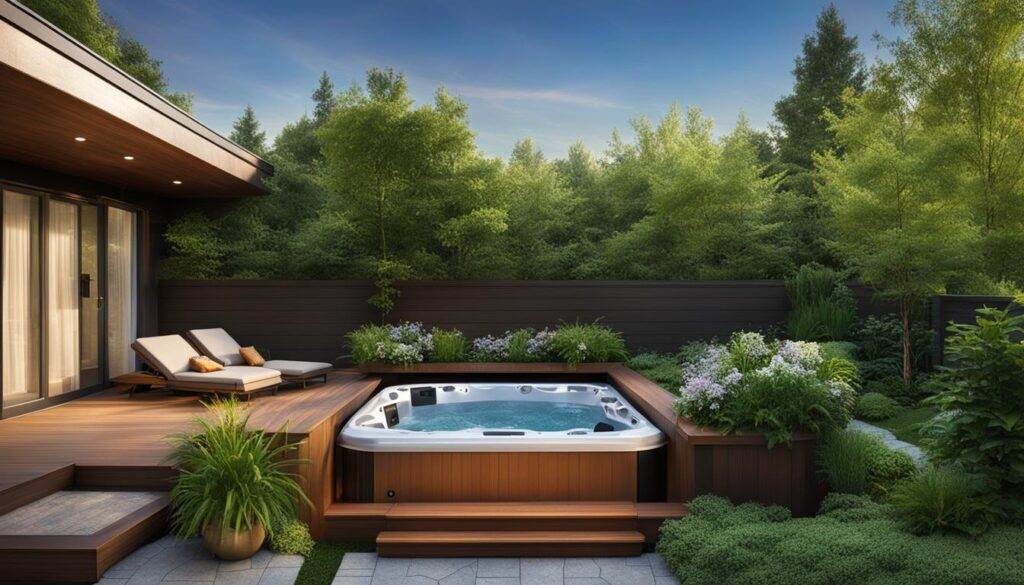
Rotationally Molded Hot Tub
1. Advantages of a Rotationally Molded Hot Tub
A rotationally molded hot tub offers several advantages that make it a popular choice for those on a budget. Here are some key advantages:
- Affordability: Rotationally molded hot tubs are generally more affordable compared to other types of hot tubs. They provide a cost-effective option for those looking to enjoy the benefits of a hot tub without spending a fortune.
- Portability: Unlike other prefabricated hot tubs, rotationally molded hot tubs are quite portable. They have empty weights of about 300 pounds, making them easier to move around compared to heavier options.
- Durability: Rotationally molded hot tubs are made of plastic, which makes them fairly durable. They are less prone to damage compared to inflatable hot tubs, making them a long-lasting investment.
2. Durability and Maintenance of Rotationally Molded Hot Tubs
Rotationally molded hot tubs are known for their durability and low maintenance requirements. Here are some factors to consider:
- Material: Rotationally molded hot tubs are made of plastic, typically polyethylene. This material is resistant to wear and tear and can withstand various weather conditions, ensuring the longevity of the hot tub.
- Easy maintenance: Cleaning a rotationally molded hot tub is relatively easy. The plastic surface is smooth, making it simple to wipe down and keep clean. The hot tub’s filtration system also helps keep the water clean and reduces the need for frequent draining and refilling.
- Limited upgrade options: While rotationally molded hot tubs offer affordability and durability, they do have limited upgrade options compared to other types of hot tubs. If having advanced features and customization options is important to you, you may want to consider other types of hot tubs.
- Energy efficiency: Rotationally molded hot tubs are not particularly energy-efficient. They may lack insulation and energy-saving features, resulting in higher operating costs compared to more energy-efficient models.
Inflatable Hot Tubs
1. Benefits and Drawbacks of Inflatable Hot Tubs
Inflatable hot tubs are a popular choice for those looking for an entry-level option in the world of hot tubs. They have their own set of benefits and drawbacks:
- Affordable entry option: Inflatable hot tubs are typically more affordable compared to other types of hot tubs. They provide a cost-effective way to enjoy the relaxation and therapeutic benefits of a hot tub.
- Easy set-up: Setting up an inflatable hot tub is a simple process. Most models come with an inflation pump that allows you to quickly inflate the tub and fill it with water. They also usually have user-friendly control panels for adjusting the temperature and jets.
- Portability: One of the main advantages of inflatable hot tubs is their portability. They can be easily deflated and transported, making them ideal for those who move frequently or want the flexibility to use the hot tub in different locations.
- Compact storage: When not in use, inflatable hot tubs can be deflated and stored in a compact space. This is especially convenient for those with limited outdoor area or who want to store the hot tub during colder months.
- Limited features: While inflatable hot tubs do provide a relaxing experience, they typically lack some of the advanced features found in other types of hot tubs. The jets in inflatable hot tubs are more like bubbles, which means they provide a gentle massaging effect rather than a strong jet stream. Additionally, most inflatable hot tubs do not have seating options, so users may need to sit on the floor or utilize inflatable cushions.
- Lower durability: Inflatable hot tubs are generally less durable compared to other types of hot tubs. They are made from PVC or similar materials, which can be punctured or damaged more easily. However, with proper care and maintenance, inflatable hot tubs can still last for several years.
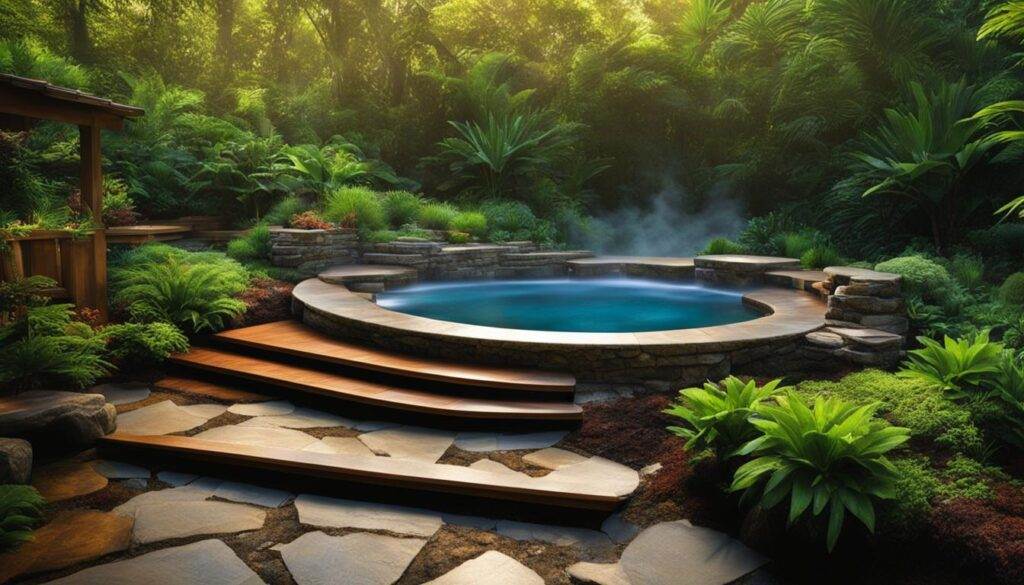
2. Maintenance and Set-up of Inflatable Hot Tubs
- Set-up: Inflatable hot tubs are relatively easy to set up. The first step is to find a suitable location for the tub. Make sure the ground is level and can support the weight of the filled tub. Next, inflate the tub using the provided pump and fill it with water. Once the tub is filled, you can adjust the temperature and jets according to your preference.
- Maintenance: Proper maintenance is essential to ensure the longevity and cleanliness of an inflatable hot tub. Regularly check and clean the filter to remove debris and maintain optimal water quality. It is also important to regularly test the water chemistry and adjust the pH levels as needed. Follow the manufacturer’s instructions for draining and refilling the tub.
- Winter storage: During the colder months or when the hot tub is not in use, it is important to properly store and protect the inflatable tub. Drain all the water from the tub and ensure it is completely dry before deflating and storing it in a clean, dry area. Avoid storing the tub in extreme temperatures or places prone to sharp objects or pests.
- Repairing punctures: If the inflatable hot tub gets punctured or damaged, it is possible to repair it with a repair kit provided by the manufacturer. Follow the instructions carefully to patch the hole and ensure the tub is fully airtight before using it again.
Inflatable hot tubs offer an affordable and portable option for enjoying the benefits of a hot tub. While they may not have all the features of traditional hot tubs, with proper care and maintenance, they can still provide a relaxing and enjoyable experience.
Swim Hot Tubs
1. Features and Benefits of Swim Hot Tubs
Swim hot tubs, also known as swim spas or exercise pools, combine the features of a hot tub with those of a swimming pool. They offer a unique and versatile experience with the following features and benefits:
- Dual functionality: Swim hot tubs allow users to enjoy both the relaxation of a hot tub and the exercise potential of a swimming pool. They are equipped with powerful jets that create a current for swimming against, providing a challenging workout. At the same time, the hot tub portion of the swim hot tub offers a place for relaxation and hydrotherapy.
- Compact size: Swim hot tubs are generally smaller in size compared to traditional swimming pools, making them suitable for homes with limited outdoor space. They are an excellent option for those who want a pool-like experience but have limited space or are unable to install a full-sized pool.
- Year-round use: Unlike traditional swimming pools, swim hot tubs can be used year-round. They are usually equipped with temperature controls, allowing users to adjust the water temperature according to their preferences. This makes swim hot tubs a great option for those who love swimming but want to enjoy it regardless of the weather.
- Customizable current speed: Swim hot tubs come with adjustable swim jets that allow users to control the speed of the current. This means that users of all swimming abilities, from beginners to experienced swimmers, can customize the current speed to their fitness level and swimming goals.
- Hydrotherapy features: Similar to regular hot tubs, swim hot tubs often have built-in hydrotherapy features such as jets that provide a massaging effect. These features can help relieve muscle tension, improve circulation, and promote relaxation after a workout.
2. Design Considerations for Swim Hot Tubs
When choosing a swim hot tub, there are several design considerations to keep in mind:
- Size and shape: Swim hot tubs come in various sizes and shapes, so it’s important to consider the available space in your outdoor area and choose a size that fits your needs. Some swim hot tubs have separate swim and hot tub areas, while others have a more integrated design.
- Current system: The type and power of the current system should be considered based on your swimming abilities and fitness goals. Look for swim hot tubs with adjustable swim jets to ensure you can customize the current speed to your preference.
- Seating and layout: Consider the seating and layout options in the hot tub area. Some swim hot tubs offer bench seating, while others have designated seats with massaging jets. Think about how many people you want to accommodate at once and choose a layout that suits your preferences.
- Additional features: Look for swim hot tubs that offer additional features such as LED lighting, Bluetooth connectivity for music, or Wi-Fi compatibility for easy control and monitoring.
Swim hot tubs provide a unique combination of exercise, relaxation, and hydrotherapy in a compact and versatile package. With their adjustable current systems, customizable design options, and year-round use, swim hot tubs are a popular choice for those looking to enjoy the benefits of both hot tubs and swimming pools in one.
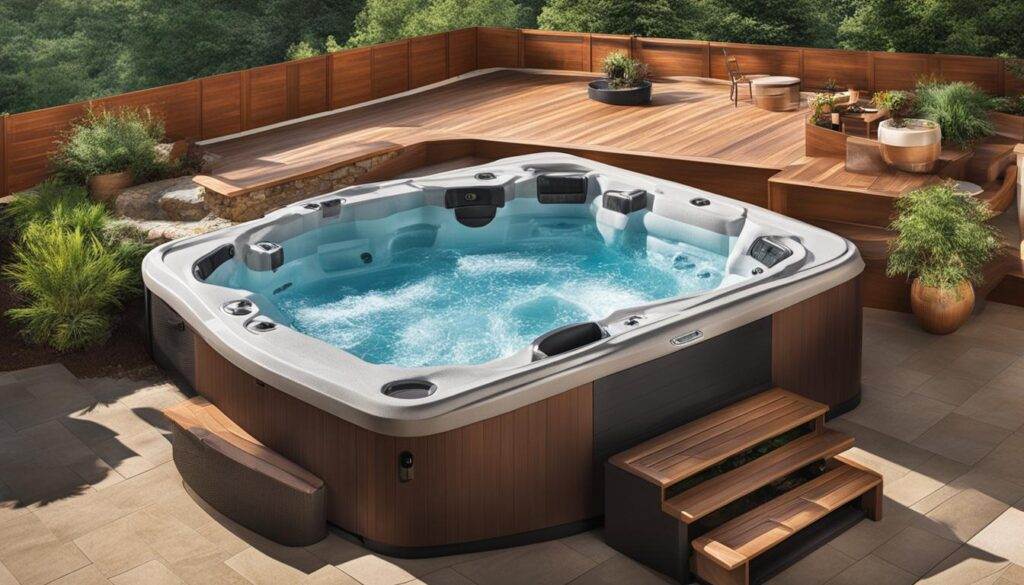
Inflatable Hot Tubs
Benefits and Drawbacks of Inflatable Hot Tubs
Inflatable hot tubs are a popular choice for those looking for an entry-level option in the world of hot tubs. They offer several benefits, but also come with a few drawbacks:
- Affordable entry option: Inflatable hot tubs are typically more affordable compared to other types of hot tubs. They provide a cost-effective way to enjoy the relaxation and therapeutic benefits of a hot tub.
- Easy set-up: Setting up an inflatable hot tub is a simple process. Most models come with an inflation pump that allows for quick inflation and filling of the tub with water. They also usually have user-friendly control panels for adjusting the temperature and jets.
- Portability: One of the main advantages of inflatable hot tubs is their portability. They can be easily deflated and transported, making them ideal for those who move frequently or want the flexibility to use the hot tub in different locations.
- Compact storage: When not in use, inflatable hot tubs can be deflated and stored in a compact space. This is especially convenient for those with limited outdoor area or who want to store the hot tub during colder months.
- Limited features: While inflatable hot tubs do provide a relaxing experience, they typically lack some of the advanced features found in other types of hot tubs. The jets in inflatable hot tubs are more like bubbles, which means they provide a gentle massaging effect rather than a strong jet stream. Additionally, most inflatable hot tubs do not have seating options, so users may need to sit on the floor or utilize inflatable cushions.
- Lower durability: Inflatable hot tubs are generally less durable compared to other types of hot tubs. They are made from PVC or similar materials, which can be punctured or damaged more easily. However, with proper care and maintenance, inflatable hot tubs can still last for several years.
Maintenance and Set-up of Inflatable Hot Tubs
- Set-up: Inflatable hot tubs are relatively easy to set up. Find a suitable location for the tub that is level and can support the weight of the filled tub. Inflate the tub using the provided pump and fill it with water. Adjust the temperature and jets according to your preference.
- Maintenance: Proper maintenance is essential to ensure the longevity and cleanliness of an inflatable hot tub. Regularly check and clean the filter to remove debris and maintain optimal water quality. Test the water chemistry and adjust the pH levels as needed. Follow the manufacturer’s instructions for draining and refilling the tub.
- Winter storage: During colder months or when the hot tub is not in use, drain all the water from the tub and ensure it is completely dry before deflating and storing it in a clean, dry area. Avoid storing the tub in extreme temperatures or places prone to sharp objects or pests.
- Repairing punctures: If the inflatable hot tub gets punctured or damaged, it is possible to repair it with a repair kit provided by the manufacturer. Follow the instructions carefully to patch the hole and ensure the tub is fully airtight before using it again.
Inflatable hot tubs offer an affordable and portable option for enjoying the benefits of a hot tub. While they may not have all the features of traditional hot tubs, with proper care and maintenance, they can still provide a relaxing and enjoyable experience.
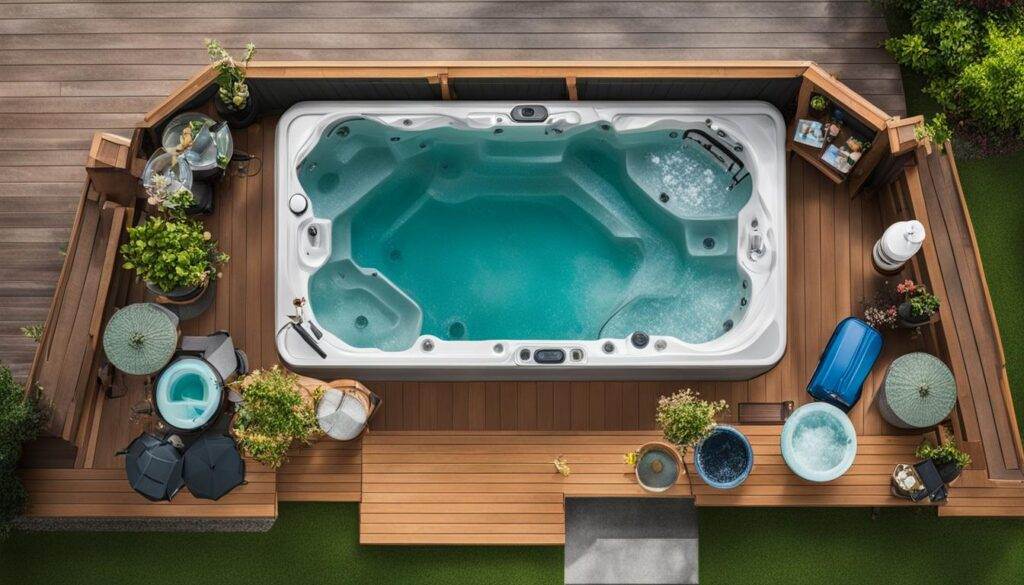
Conclusion
In conclusion, there are many different types of hot tubs available in the market, each with its own set of benefits and considerations. Inflatable hot tubs are an affordable and portable option, making them a popular choice for entry-level hot tub users. They are easy to set up and store, providing a convenient solution for those with limited outdoor space or who want the flexibility to move their hot tub. However, inflatable hot tubs may lack some advanced features found in other types of hot tubs and may not be as durable. It is important to consider your needs and preferences when choosing the right hot tub for you. Whether you opt for an inflatable hot tub or a custom-designed luxury hot tub, Aqua Warehouse is here to provide high-quality products and excellent customer service to enhance your hot tub experience.
Resources
Additional Sources and Recommendations for Hot Tub Buyers
When it comes to purchasing a hot tub, it’s important to do thorough research and consider various factors before making a decision. Here are some additional resources and recommendations to help you in your hot tub-buying journey:
- Online customer reviews: Reading reviews from other hot tub owners can provide valuable insights into the performance, durability, and overall satisfaction of different hot tub models. Websites such as Amazon, Home Depot, and Wayfair often feature customer reviews for popular hot tub brands.
- Hot tub forums and online communities: Engaging in discussions on hot tub forums and online communities can help you gather information, ask questions, and hear about personal experiences from hot tub owners. Websites such as Hot Tub Insider, Trouble Free Pool, and GardenWeb have active communities where users can connect and share their knowledge.
- Retailer websites: Visiting the websites of reputable hot tub retailers can give you access to detailed product specifications, pricing, and warranty information. Aqua Warehouse, as a trusted hot tub provider, offers a wide range of hot tubs and swim spas, along with resources and articles to assist buyers in making an informed decision.
- Consultation with a professional: If you’re unsure about which hot tub model will best suit your needs and preferences, consider consulting with a hot tub professional. They can provide personalized recommendations based on factors such as budget, space constraints, desired features, and maintenance requirements.
- Attending trade shows and expos: Trade shows and expos dedicated to hot tubs and spas are excellent opportunities to explore a wide variety of models and learn about the latest innovations in the industry. It’s a chance to speak directly with manufacturers, compare different options, and take advantage of any show discounts or promotions.
Remember, purchasing a hot tub is a significant investment, and it’s essential to choose a reputable retailer with a proven track record of quality products and excellent customer service. Aqua Warehouse, with its long-standing reputation and commitment to customer satisfaction, is a reliable choice for hot tub buyers.
By utilizing these additional resources and recommendations, you can gather the necessary information to make an educated decision when selecting the perfect hot tub for your needs. Whether you opt for an inflatable hot tub or a high-end custom-designed model, Aqua Warehouse is dedicated to ensuring a positive hot tub ownership experience through its exceptional products and customer support.

